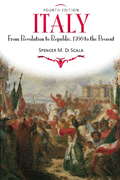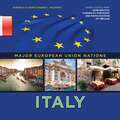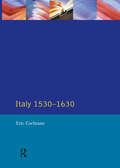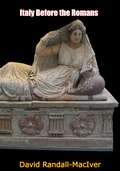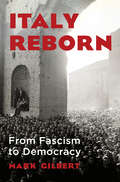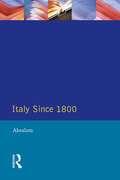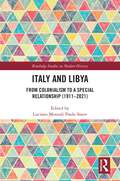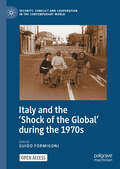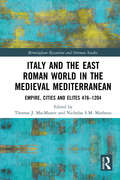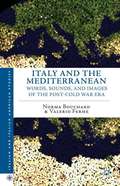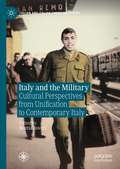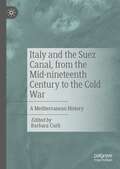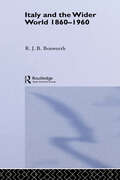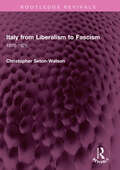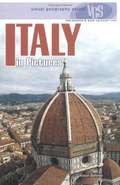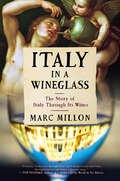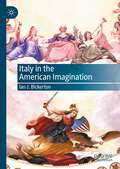- Table View
- List View
Italy
by Spencer DiscalaSpans three centuries of Italian history, weaving together the countryOCOs social, political, and economic developments and orienting them within the larger framework of European history. "
Italy
by Spencer M. DiscalaThis essential book fills a serious gap in the field by synthesizing modern Italian history and placing it in a fully European context. Emphasizing globalization, Italy traces the country's transformation from a land of emigration to one of immigration and its growing cultural importance. Including coverage of the April 2008 elections, this updated edition offers expanded examinations of contemporary Italy's economic, social, and cultural development, a deepened discussion on immigration, and four new biographical sketches. Author Spencer M. Di Scala discusses the role of women, gives ample attention to the Italian South, and provides a picture of how ordinary Italians live. Cast in a clear and lively style that will appeal to readers, this comprehensive account is an indispensable addition to the field.
Italy
by Spencer M. DiscalaThis essential book fills a serious gap in the field by synthesizing modern Italian history and placing it in a fully European context. Emphasizing globalization, Italy traces the country's transformation from a land of emigration to one of immigration and its growing cultural importance. Including coverage of the April 2008 elections, this updated edition offers expanded examinations of contemporary Italy's economic, social, and cultural development, a deepened discussion on immigration, and four new biographical sketches. Author Spencer M. Di Scala discusses the role of women, gives ample attention to the Italian South, and provides a picture of how ordinary Italians live. Cast in a clear and lively style that will appeal to readers, this comprehensive account is an indispensable addition to the field.
Italy (Major European Union Nations)
by Ademola O. SadekItaly is a tourist destination for thousands of people every year. It was also a founding member of the EU in 1952. Italy has a long history, from the Romans to the Renaissance. Today it faces modern-day issues such as immigration, women's rights, and the economic recession. Discover more about this exciting, modern nation!
Italy 1530-1630 (Longman History of Italy)
by Eric CochraneThis book covers one of the more obscure periods of Italian history. What we know of it is presented almost always pejoratively: an unrelieved tale of political absolution, rural refeudalisation, economic crisis, religious repression and cultural decline. But this picture is both incomplete and inaccurate, and in this important new survey Eric Cochrane has at last given the period its due.
Italy Before Italy: Institutions, Conflicts and Political Hopes in the Italian States, 1815-1860 (Routledge Studies in Modern European History)
by Marco SoresinaItalian unification is one of the pivotal events in European history but the period leading up to Risorgimento has often been analysed in less detail. This book focuses on the history of the Italian states between 1815 and 1860 focusing on state institutions, international relations, economic and fiscal policies, living conditions and culture.
Italy Before Rome: A Sourcebook (Routledge Sourcebooks for the Ancient World)
by Katherine McDonaldThis book brings together sources translated from a wide variety of ancient languages to showcase the rich history of pre-Roman Italy, including its cultures, politics, trade, languages, writing systems, religious rituals, magical practices, and conflicts. This book allows readers to access diverse sources relating to the history and cultures of pre-Roman Italy. It gathers and translates sources from both Greek and Latin literature and ancient inscriptions in multiple languages and gives commentary to highlight areas of particular interest. The thematic organisation of this sourcebook helps readers to make connections across languages and communities, and showcases the interconnectedness of ancient Italy. This book includes maps, a timeline, and guides to further reading, making it accessible to students and other readers who are new to this subject. Italy Before Rome is aimed at undergraduate and graduate students, including those who have not studied the ancient world before. It is also intended to be useful to researchers approaching this material for the first time, and to university and schoolteachers looking for an overview of early Italian sources.
Italy Before the Romans
by David Randall-MacIverFirst published in 1928, this book by archaeologist and author David Randall-MacIver provides a detailed description of Italy and its chief peoples before it was conquered by the Romans in 509 B.C. Randall-MacIver constructs his study through reference to the “great mass of Archaeological discoveries made in Italy during the last seventy years” (i.e. 1860’s-1920’s).A wonderful addition to your ancient history collection.Richly illustrated throughout.“Historians have deliberately kept silence as to all Italian peoples except the Roman. But it is obvious that the view which they give is incomplete. The Romans were not a highly civilized people in the early days of the Republic. Italy was completely civilized before its conquest by Rome. Archaeology can give a picture of the life of Italian peoples scarcely known to history.”—Introduction
Italy In The Second World War: Memories And Documents
by Muriel Currey Marshal Pietro BadoglioMarshal Pietro Badolgio was involved in the highest levels of the Italian political hierarchy ever since his early successes in the First World War, for which he was promoted General. He was head of the Italian Armed Forces from 1925 to 1940, and did his best to raise the military to a level that might match the expansionist views of Mussolini. He presided over the brutal invasion of Ethiopia, but nationally he acted as a counter-balance to Mussolini's pre-World War II schemes. Unable to stop the inevitable disaster following the Italian-German Pact of Steel and the onset of war, he resigned as Chief Of Staff after the humiliating reverses of the Italian invasion of Greece. He was brought back into the political spotlight in 1943, after the fall of Mussolini, and was named Prime Minister of Italy during the turbulent months of their volte face change of sides. His position was unenviable, caught between the Italian people who cried out for peace and the Allied powers who pursued German defeat in Italy by armed force. In this fascinating book he recounts his memories and recollections of Italy during the Second World War, particularly focussed on his attempts to hold the country together in 1943 and 1944.
Italy Reborn: From Fascism to Democracy
by Mark GilbertA brilliant, meticulously researched account of the birth of Italian democracy after Mussolini. The rebirth of Italy after the Second World War is one of the most impressive political transformations in modern European history. In 1945, post-fascist Italy was devastated by war, and its reputation in the international arena was nil. Yet by December 1955, when Italy was admitted to the United Nations, the nation had contested three acrimonious but free general elections, had a flourishing press, and was a leader in the rebuilding of Europe. This is the dramatic story told by Italy Reborn. It charts the descent of Italy into Fascism, the scale of the wartime disaster, the Italian resistance to Nazi occupation, the horrors of civil war, and the establishment of the Republic in 1946. The Cold War divided, in 1947, the coalition of parties that had led the resistance to Fascism and Nazism. The book’s final chapters deal with the consolidation of Italian democracy and with the statesmanship of Alcide De Gasperi, the premier from December 1945 to August 1953. The book persuasively argues that De Gasperi deserves more credit than he has typically been accorded for Italy’s postwar democratization and shows how Italian democracy was constructed on a sound foundation—which is why it has been able to survive its many postwar crises. Largely based on contemporary Italian sources, Italy Reborn is both an original account of this crucial period in Italian history and a remarkable example of how democracies are made.
Italy Since 1800: A Nation in the Balance? (The Present and The Past)
by Roger AbaslomSince unification, Italy has grown from a backward agrarian society into one of the world's leading industrial powers. Yet her history exhibits spectacular disunities, inconsistencies and paradoxes. Dominated by political Catholicism, she has also been home to Fascism, the mafia, and the largest Communist movement outside the Eastern Bloc. Her politics are notoriously fissiparous - yet policy itself never changes. Until now. This timely, absorbing and richly illustrated account of the historical development of the Italian nation-state traces the main paradoxes of what `Italy' has been, and questions what she may become.
Italy and Its Eastern Border, 1866-2016 (Routledge Studies in Modern European History #35)
by Marina CattaruzzaThis is the first scholarly work in Modern European History which elucidates consistently how border issues affect the history of nations and states in the 19th and 20th centuries. The book rethinks the Italian history of the last 150 years from the perspective of its eastern periphery and of the profound impact that events on the border had on the core of the country.
Italy and Libya: From Colonialism to a Special Relationship (1911–2021) (Routledge Studies in Modern History)
by Luciano Monzali, Paolo SoaveThis volume proposes a historical analysis of Italian-Libyan relations in contemporary times. After examining the colonialism of liberal Italy, which in 1911 culminated in the military campaign for the conquest of the Libyan regions, it evaluates the impact of fascism in Libya and the attempt to launch a broader pro-Arab policy. The third section analyzes the construction of the so-called 'special relationship' between Rome and Tripoli since the 50s when an economic interdependence between the Libyan oil producer and the Italian industrial power was pursued despite political differences. Finally, the volume also focuses on the dramatic implosion of Libya and the loss of its political unity following the fall of the Gaddafi regime, which on the one hand, scaled back Italy's regional role, on the other, spread instability throughout the Euro-Mediterranean area. The volume uses a historiographical methodology focused on primary sources and updated scientific literature but also includes specialized analyses of the most current scenarios. This is the first systematic work on the Italian-Libyan relationship produced in English, accessible to area scholars, specialists, analysts and students, who intend to deepen their understanding of one of the pivotal factors of the Euro-Mediterranean balance, which is currently missing.
Italy and the 'Shock of the Global' during the 1970s (Security, Conflict and Cooperation in the Contemporary World)
by Guido FormigoniThis open access book explores how Italy experienced the crucial period of transition that has come to be known as the ‘Shock of the Global’ during the 1970s. This decade marked a change between the prevailing socio-political and economic structures of the post-war world – the ‘golden age’ of national and Fordist capitalism – and a new horizon which would become much more integrated at a global and transnational level. Drawing from a diverse range of sources, the collection focuses on the perceptions of the crisis and the novelties of the globalization process, as well as the complex process of adjustment that occurred as a result, revealing how events during the 1970s impacted Italy’s collective mentality, its social groups, political parties and culture. Comprising 23 brief chapters, each examining a symbolic event of the decade, this book acts as a starting point for studying the Italian perception of international change. An insightful read for anyone researching modern Italian history, globalization or transnational history, this book demonstrates how Italian culture, society and politics reacted to international stimuli from abroad during the 1970s.
Italy and the East Roman World in the Medieval Mediterranean: Empire, Cities and Elites, 476-1204 (Birmingham Byzantine and Ottoman Studies #30)
by Thomas J. MacMasterItaly and the East Roman World in the Medieval Mediterranean addresses the understudied topic of the Italian peninsula’s relationship to the continuation of the Roman Empire in the East, across the early and central Middle Ages. The East Roman world, commonly known by the ahistorical term "Byzantium", is generally imagined as an Eastern Mediterranean empire, with Italy part of the medieval "West". Across 18 individually authored chapters, an introduction and conclusion, this volume makes a different case: for an East Roman world of which Italy forms a crucial part, and an Italian peninsula which is inextricably connected to—and, indeed, includes—regions ruled from Constantinople. Celebrating a scholar whose work has led this field over several decades, Thomas S. Brown, the chapters focus on the general themes of empire, cities and elites, and explore these from the angles of sources and historiography, archaeology, social, political and economic history, and more besides. With contributions from established and early career scholars, elucidating particular issues of scholarship as well as general historical developments, the volume provides both immediate contributions and opens space for a new generation of readers and scholars to a growing field.
Italy and the Mediterranean
by Norma Bouchard Valerio FermeThe Mediterranean has always loomed large in the history and culture of Italy, and since the 1980s this relationship has been represented in ever more varied forms as both national and regional identities have evolved within a globalized context. This interdisciplinary volume puts Italian artists (writers, musicians, and filmmakers) and intellectuals (philosophers, sociologists, and political scientists) in conversation with each other to explore Italy's Mediterranean identity while questioning the boundaries between Self and Other, and between native and foreign bodies. By moving beyond nation-centric models of cultural and ethnic homogeneity based on myths of progress and rationality, these wide-ranging contributions fashion new ways of belonging that transcend the cultural, economic, religious, and social categories that have characterized post Cold War Italy and Europe.
Italy and the Military: Cultural Perspectives from Unification to Contemporary Italy (Italian and Italian American Studies)
by Mattia RoveriThis book sheds new light on the role of the military in Italian society and culture during war and peacetime by bringing together a whole host of contributors across the interdisciplinary spectrum of Italian Studies. Divided into five thematic units, this volume examines the continuous and multifaceted impact of the military on modern and contemporary Italy. The Italian context offers a particularly fertile ground for studying the cultural impact of the military because the institution was used not only for defensive/offensive purposes, but also to unify the country and to spread ideas of socio-cultural and technological development across its diverse population.
Italy and the Suez Canal, from the Mid-nineteenth Century to the Cold War: A Mediterranean History
by Barbara CurliConceived in the 1850s and opened to navigation in 1869, the Suez Canal’s construction coincided with Italy’s path to unification and its first foray into nineteenth-century globalization. Since then, the history of Italy and the Canal have intertwined in many ways, throughout in peace and war. This edited collection explores the fundamental technical, diplomatic and financial contributions that Italy made to the production of the Canal and to its subsequent development, from the mid-nineteenth century to the Cold War. Drawing from unpublished public and private archival sources, this book is the first comprehensive account of this long and multifaceted relationship, providing innovative perspectives on Italy’s diplomatic, economic, social, colonial and cultural history. An insightful read for those studying maritime, diplomatic or Italian history, this book contributes to a growing body of research on the Canal, which has largely emerged from international business, labour and social history, and offers new insights into the Euro-Mediterranean region.
Italy and the Wider World: 1860-1960
by R.J.B. BosworthRichard Bosworth's overview of Italy's role in European and world politics from 1860 to 1960 is lively and iconclastic. Based on a combination of primary research and secondary material he examines Italian diplomacy, military power, commerce, culture, tourism and ideology. His account challenges many aspects of current Italian historiography and offers an original vision of the place of Italy in modern history.
Italy from Liberalism to Fascism: 1870-1925 (Routledge Revivals)
by Christopher Seton-WatsonFirst published in 1967, Italy from Liberalism to Fascism is essentially the political history of Italy, concerned with both domestic and foreign policy and their interaction. Designed in chronological order, the book is divided into four parts: the consolidation of Italy after its unification; the stresses and strains the country went through; the expansion of liberalism; and the onset and development of fascism. This seminal book on the history of Italy will be of interest to students of history and political science.
Italy in Crisis: 1494
by Jane E. Everson Diego Zancani"Italy in Crisis: 1494 is a collection of essays which were originally presented at a conference organized at the Institute of Romance Studies in London. They cover the most Important aspects of the history, literature, astrology and thought of the 1490s, when major figures such as Lorenzo de' Medici, Angelo Poliziano, Luigi Pulci, and Boiardo, the author of the Orlando Innamorato, disappeared from the Italian scene. The contributors are Alison Brown, Remo Catani, Peter Brand, Marco Dorigatti, Mark Davie, Martin McLaughlin, Letizla Panlzza and Denis Reldy."
Italy in Pictures (Visual Geography)
by Alison BehnkeA historical and current look at Italy, discussing the land, the government, the people, and the economy.
Italy in a Wineglass: The Story of Italy Through Its Wines
by Marc Millon&“Compulsory reading&” - The International Wine ReviewA leading travel writer guides readers on a sumptuous journey through time and flavor to understand how and why wine transformed Italy . . .&“It&’s not often that a wine writer can engross and enthrall you with the history of a culture where wine merely plays its part along with many other players. Marc Millon does this absorbingly and impressively, telling the intriguing, exasperating, but ultimately optimistic story of Italy and its wines.&” —OZ CLARKE, author of The History of Wine in 100 BottlesThe world is enamored with Italy: its culture, art, food, and fashion, its beautiful landscapes, and famous cities—and, of course, its wine.From the ancient Greeks to the Medici, and from fascism to feminism, Italy has always been entwined with wine. Through the millennia, it has been a celebratory libation at great events, given solace in times of despair, and fortified warriors before battle. Whether Possessioni Rosso, still made by descendants of Dante; Barolo &“Lazzarito,&” from a wine estate founded by the son of Italy&’s first king; or Terre Rosse di Giabbascio, pressed from grapes grown on ex-Mafia land, the peninsula&’s wines provide an intoxicating insight into the ideas, events, and personalities that shaped Italian history.If history can sometimes be throat-achingly dry, writer and wine expert Marc Millon serves up a delightfully fresh take on Italy&’s past, present, and future, best enjoyed with a glass in hand.
Italy in the Age of the Risorgimento 1790 - 1870 (Longman History of Italy)
by Harry HearderEstablished as a standard work - covers the whole of Italy not just the Risorgimento itself.
Italy in the American Imagination
by Ian J. BickertonIt is almost impossible to imagine the United States without making reference to Italy. There is scarcely any aspect of American culture untouched by Italy—its history, art, architecture, fashion, film, music, the mafia, or even more viscerally its food. Italy occupies a space of near mythical proportion in the American imagination. When many Americans think of, or dream about and imagine, the good life, how and where they would like to live, they think most often of Italy; the beauty, the life-style, the romance, the excitement and sense of adventure that Italy offers.By looking at the fluid and multi-dimensional imaginative interactions Americans have with Italian culture and society, this comprehensive and robust volume offers a new and novel way of exploring the influence of Italy upon the United States. University of New South Wales historian Ian James Bickerton argues that if we wish to understand the United States, and how Americans define themselves and their nation, it is vital to examine how they imagine themselves, and he demonstrates that throughout U.S. history one of the most powerful stimulants shaping the imaginary world of Americans has been Italy.
